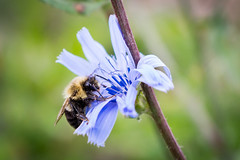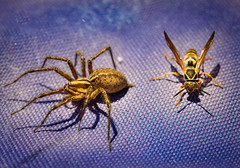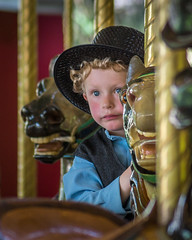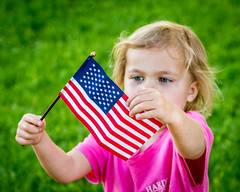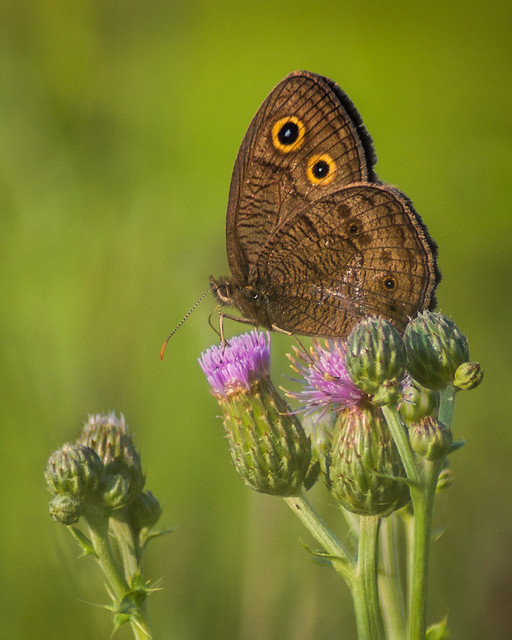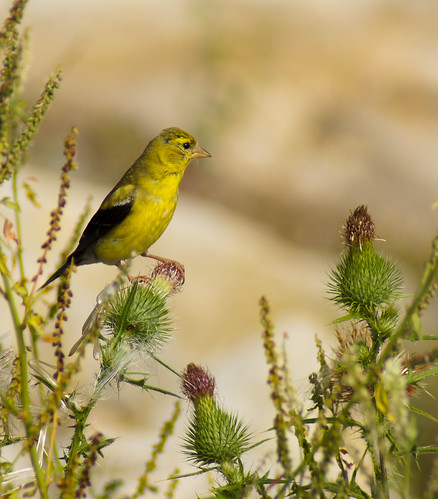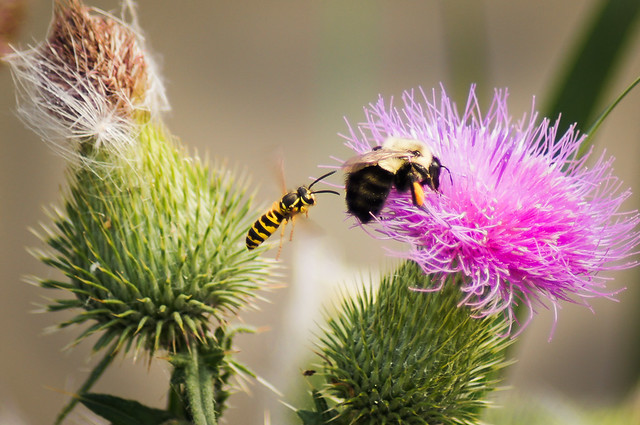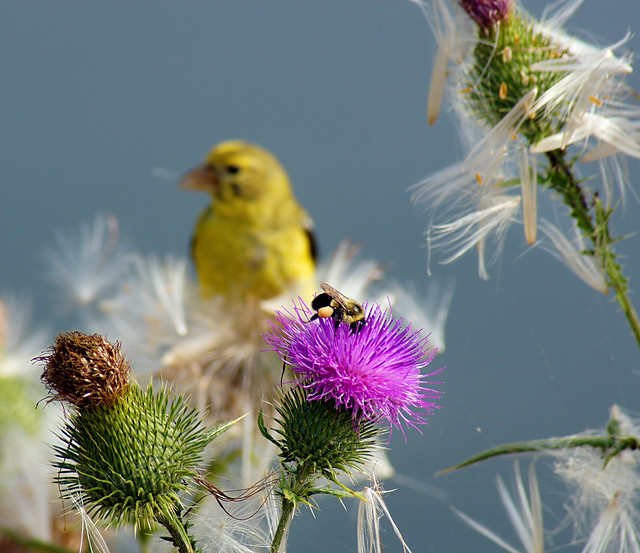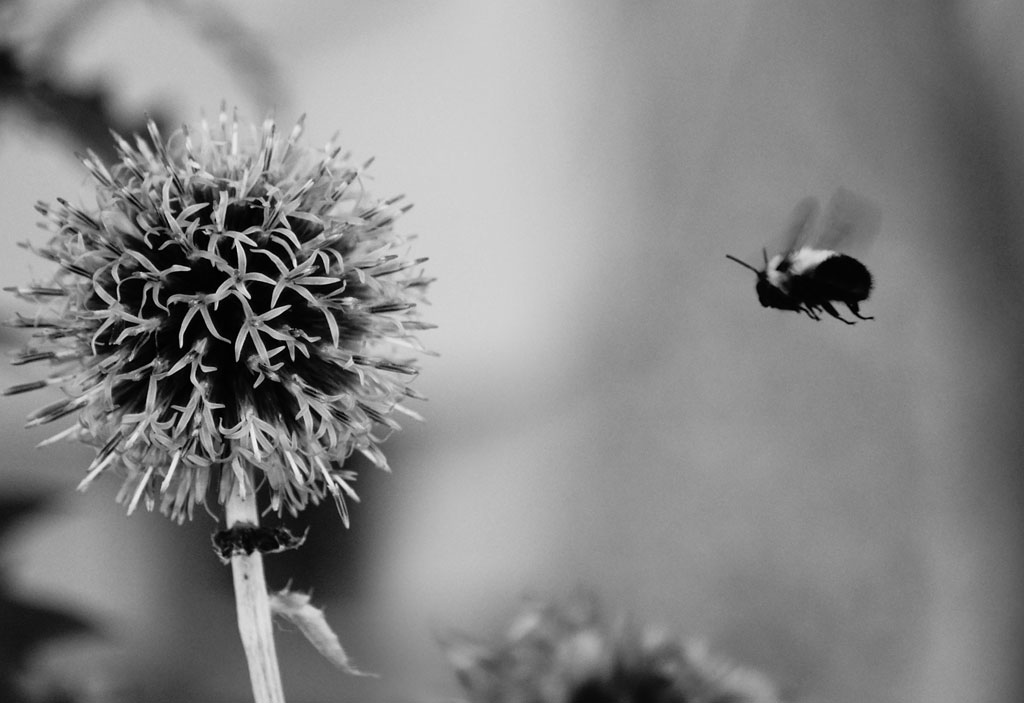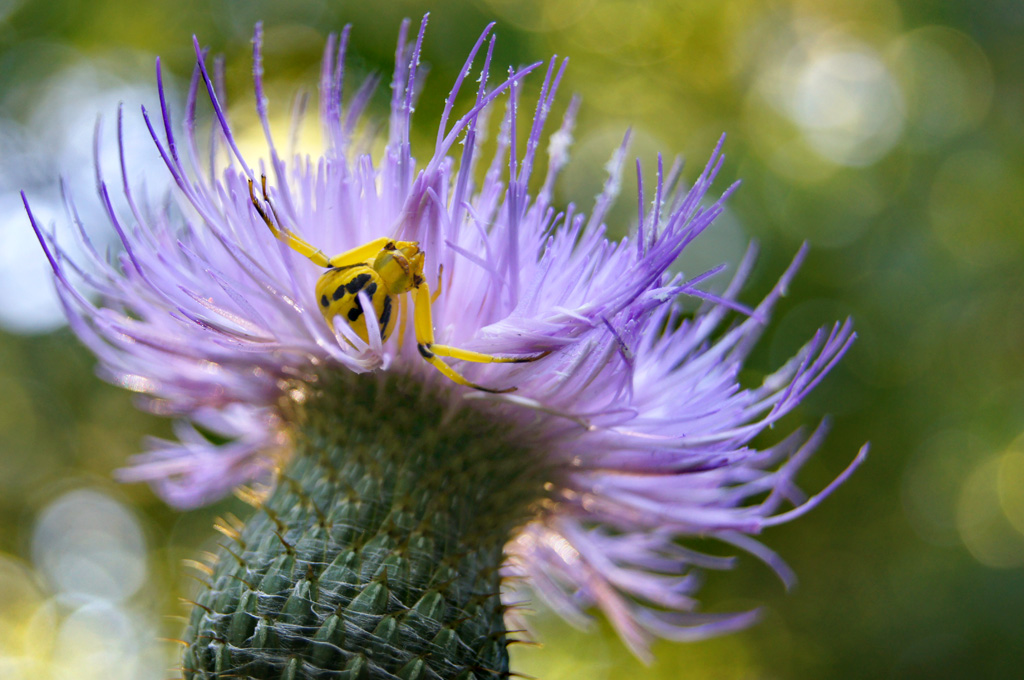Thistle
Cruel Intentions
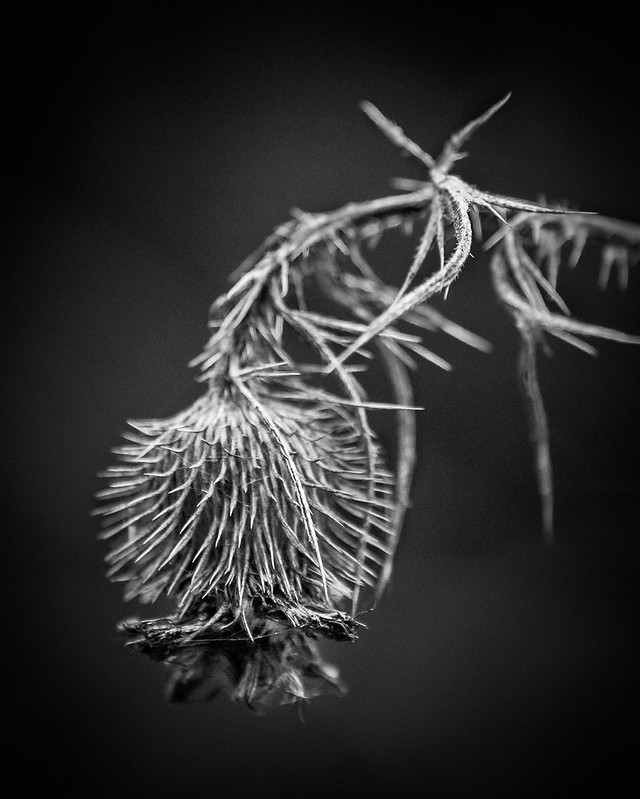 One person’s weed is another person’s flower. This one (a dried up thistle in the wild) just seems evil.
One person’s weed is another person’s flower. This one (a dried up thistle in the wild) just seems evil.
I snapped this photo on a recent hike thought the woods to find some autumn color. It wasn’t colorful, for sure, but I thought it was interesting – in gruesome kind of way.
You can view a larger, more detailed version of this photo by clicking on it. When you do, a new browser tab will open with a full-screen view.
All of the photos I post are available for purchase. If you’d like to buy one, click on the blue “Buy this Online” bar below for a variety of print and frame options or contact me for digital purchase and licensing options.
World of Chaos
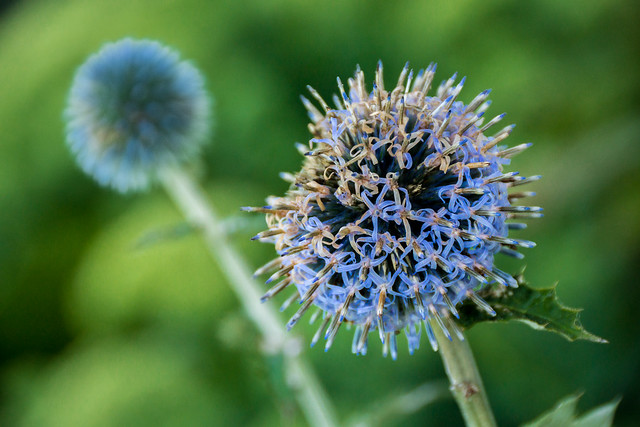
The globe thistle is a unique, flowering thistle and is garden friendly. It provides an appealing contrast of color and texture to the flower bed in mid summer.
I didn’t know these were called “Globe Thistles” until I looked them up to provide more info for this post. This photo was taken in one of the flowerbeds at our home.
According to Gardening Know How…
Echinops is the botanical name for globe thistle. They are stunning flowers with deep dark blue petals set in a spiky frame. The leaves are deeply notched, dark green on top and slightly silver underneath and slightly hairy. The plants are native to Asia and Europe and the name means hedgehog in Greek, which is appropriately referencing the prickly blooms. Globe thistle flowers make excellent dried displays and last for years as part of an everlasting flower display.
You can get a better, more detailed view of this image by clicking on the photo.
All of the photos I post are available for purchase. If you’d like to buy one, click on the blue “Buy this Online” bar below for a variety of print and frame options or contact me for digital purchase and licensing options.
Pauper’s Throne
This unlikely king takes a rather stately stance on an even more unlikely throne. This brown butterfly was photographed at the edge of our backyard in rural N.E. Wisconsin.
I spent a good deal of time looking for a similar butterfly on Google. I’m sure I looked through thousands of images, but was never able to find another that looked just like it. Consequently, I have no idea what kind of butterfly it was.
You can get a closer look by viewing the full-screen version by simply clicking on the image.
All of the photos I post are available for purchase. If you’d like to buy one, click on the blue “Buy this Online” bar below for a variety of print and frame options or contact me for digital purchase and licensing options.
Goldfinch on Lookout
An male American Goldfinch looks over the surroundings, comfortably perched on a purple thistle.
This particular bird had a staring role in a couple of earlier posts – Fan Dancer and Watchful Eye. He was not particularly shy and allowed me to get closer than most birds will. I was grateful.
To get a larger view (provided you have a large size monitor), click on the photo.
Blind Side Attack
While working over a purple thistle, this bumble bee was attacked from behind by another competitor. The skirmish was short and seemed pretty insignificant. After bouncing off the backside of the busy bee, the aggressor simply flew away. I’m guessing, it flew off to look for someone more its own size to pick on.
To view more of the detail in a larger version, simply click on the image.
Watchful Eye
Here’s a little touch of nature for you. I stopped to take some photos around the harbor at Algoma, Wisconsin. It wasn’t a foggy day elsewhere, but conditions were right to create a foggy area around the piers and lighthouse. I took a few photos (some I’ll be posting later) of the pier and a fisherman in the fog, and the lighthouse and boats.
As I finished and headed back to my vehicle, I noticed a few wildflowers growing near the water. I stopped to take a few random shots. Then I noticed a few bees – always a favorite photographic subject of mine – so I stopped to take a few photos of them. Then, as I started to leave again, I noticed a flash of yellow. An American Goldfinch landed in a nearby patch of thistles to enjoy a meal. It didn’t seem bothered by my presence, so I started taking photos. (Some I’ll post later.)
While concentrating on the Goldfinch, I happened to notice a bee in the foreground and refocused on the bee for awhile…as the bird continued to feast in the background.
The one thing I don’t like about this image (and others in the batch) is the background. I think it looks unnatural and fake. The background is simply the water of the harbor. I would have preferred something that had a little more color variation, instead of the flat blue, but I wasn’t able to change my position to create a different look. The thistles were only a foot or two from the water and I was shooting from a position higher than the bird.
If you’d like to see a larger version, just click on the photo.
This photo, and another cropped version, is available for sale. To see pricing, click on the blue bar below.
The Beeline
Beeline (noun) 1. direct, straight course. 2. To move swiftly in a direct, straight course.
One of my “quests” this summer was to capture a bee in flight. They’re small, quick and errattic. Hard to catch in focus. So far, none of my efforts have come close to what I would deem, “successful.”
The image above is the best I’ve managed…so far…and it was by accident. (That happens more than I might like to admit.)
I was taking photos around a flower bed beside our house. While I was changing camera settings, I accidentally pressed the shutter button. A that exact moment, a bee happened to be zipping into the frame…and voilá.
If I were trying for it, I wouldn’t try in black and white, but looking at this, I really like the intensity it creates. The bee – with his straight antennae, trailing legs and blurred wings – looks like he is on a do-or-die mission and will not be denied.
To see a larger version of this image, just click on it.
To see more bee photos, check out the Bugs & Spiders gallery.
Fatal Attraction
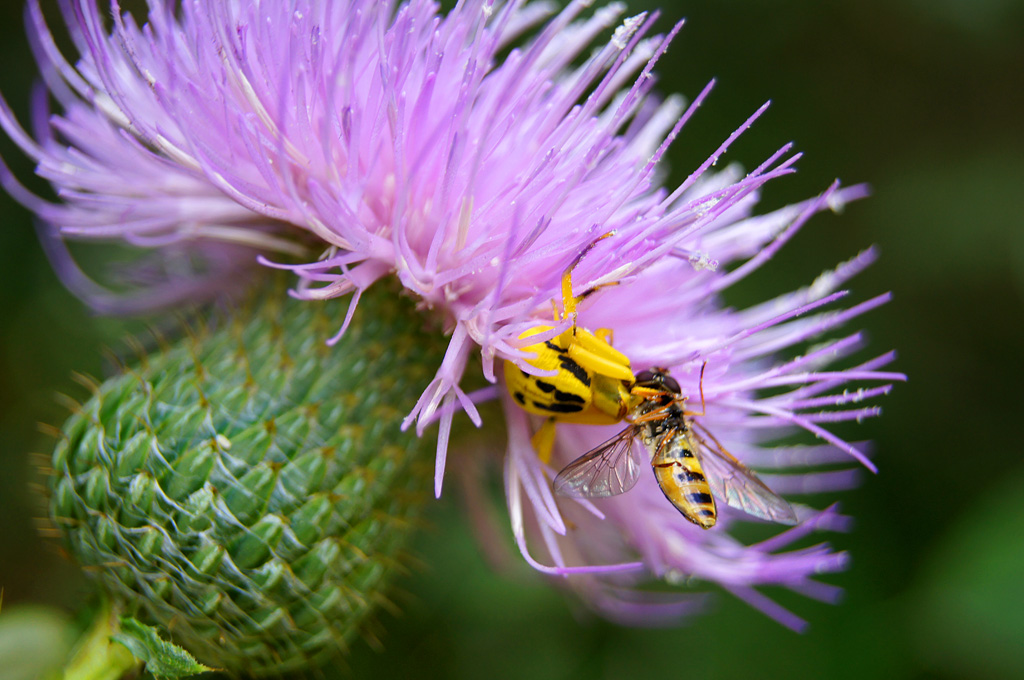
I discovered yellow spiders hiding among the the thistles. I assumed they were waiting for unsuspecting prey. I took some photos, downloaded them to my computer and posted them to this blog under the title Dangerously Alluring Beauty.
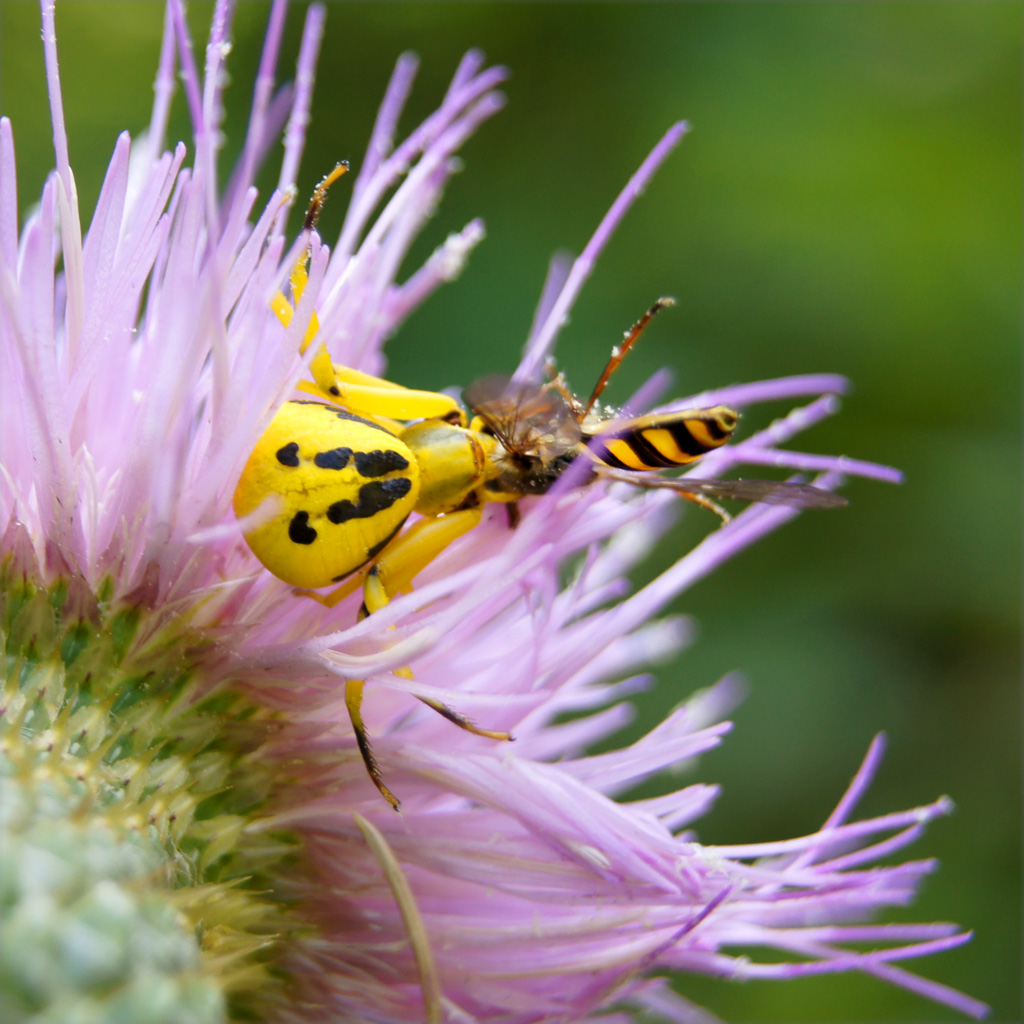 Several hours later, I went back to check on them. I was right! This is the same thistle and spider from the previous post.
Several hours later, I went back to check on them. I was right! This is the same thistle and spider from the previous post.
As you can see, a small bee, buzzing from flower to flower, attracted by the thistle, received an instant invitation to lunch.
The image on the right is the same scene from a different angle.
I wish I had hung around long enough to catch the action live. However, it just so happens, when I finished photographing this carnage, I noticed a similar yellow spider, poised with arms open wide, waiting for a its meal on a yellow flower. Then a bug came along. I started snapping pictures. The bug walked around the flower until it finally came face to face with the spider…and then…
You’ll have to watch for those images in a future post to see how it turned out.
To view larger versions of either of these photos, just click on them.
Dangerously Alluring Beauty
I went for another walk in the Missouri woods with my camera and noticed something new among the thistles.
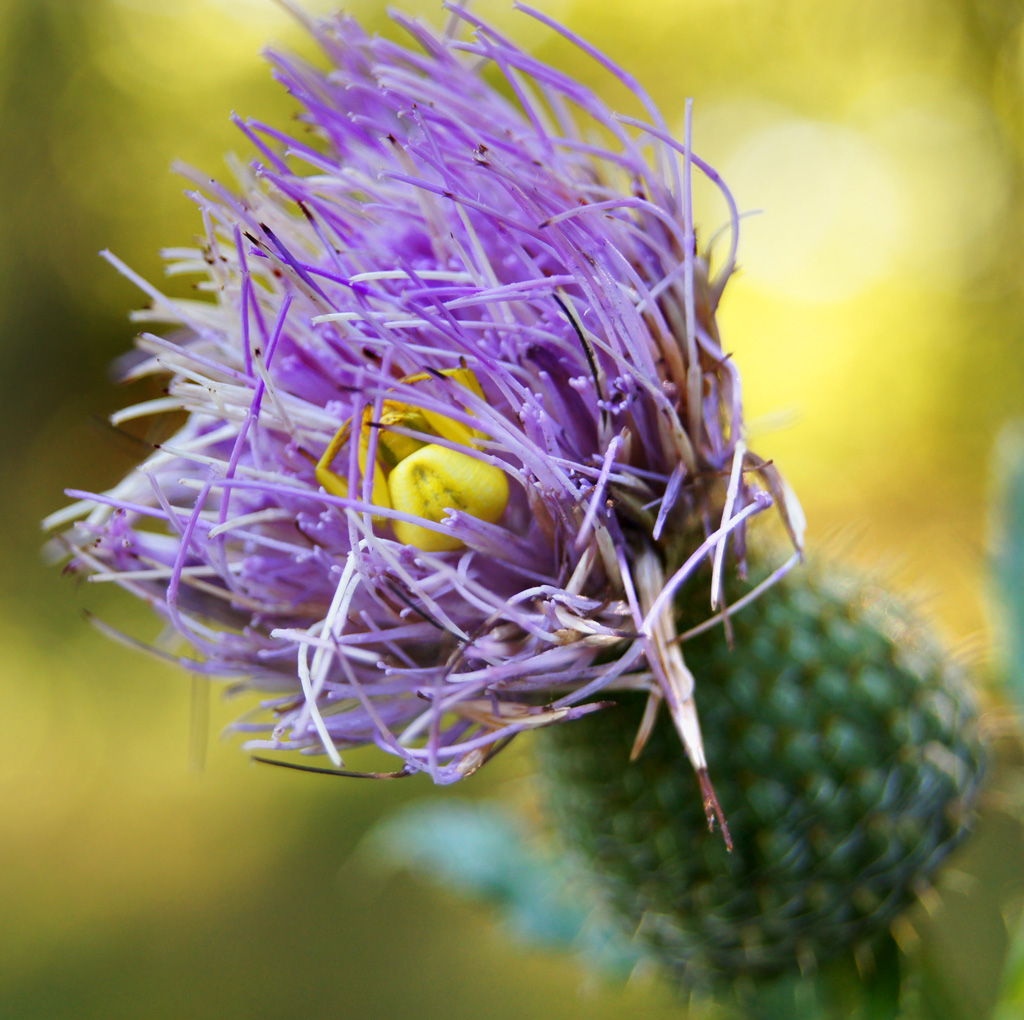 This yellow and black spider was strategically positioned and patiently waiting to strike insects who may be attracted to the colorful thistle.
This yellow and black spider was strategically positioned and patiently waiting to strike insects who may be attracted to the colorful thistle.
If you look closely at the image above, it looks like some of the thistle is twisted in strands to the side – giving the spider easier access to any prey that might land on the top of the flower. Is the spider smart enough to make an easier path to the kill or is it just a naturally occurring coincidence? I wonder.
The photo to the right show another spider snugly tucked deep in the strands of the thistle. Waiting…waiting…waiting…
Now that I look at them, maybe I should have waited to see and document what happens. It might have taken a long time with me just a few inches from the blossoms. The spiders are more patient than I am.
You can get a closer look at either photo by simply clicking on them.
Thistles on Display
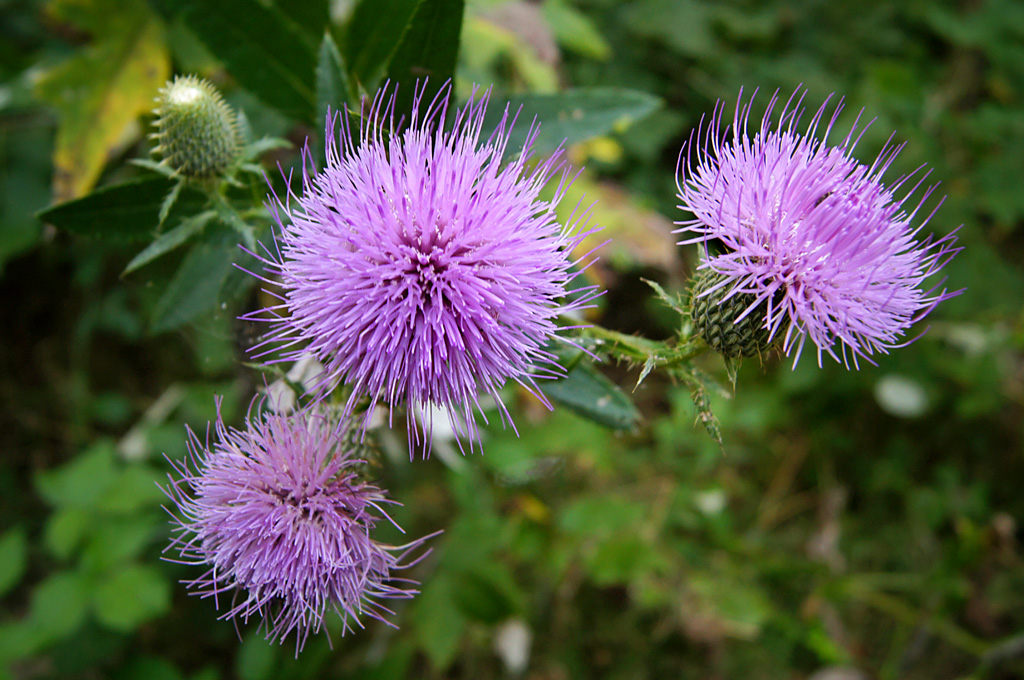
I took a walk through the woods in Missouri and came across this clump of thistles.
I have a difficult time walking outdoors with my camera and not photographing every flower of color I encounter…even if I have a dozen images of the same kind flower…even when they’re weeds.
Here’s a little of what Wikipedia says about thistles…
Thistle is the common name of a group of flowering plants characterised by leaves with sharp prickles on the margins, mostly in the family Asteraceae. Prickles often occur all over the plant – on surfaces such as those of the stem and flat parts of leaves. These are an adaptation that protects the plant against herbivorous animals, discouraging them from feeding on the plant. Typically, an involucre with a clasping shape of a cup or urn subtends each of a thistle’s flowerheads.
In the language of flowers, the thistle (like the burr) is an ancient Celtic symbol of nobility of character as well as of birth, for the wounding or provocation of a thistle yields punishment.
The thistle has been the national emblem of Scotland since the reign of Alexander III (1249–1286) and was used on silver coins issued by James III in 1470. It is the symbol of the Order of the Thistle, a high chivalric order of Scotland. It is found in many Scottish symbols and as the name of several Scottish football clubs. The thistle, crowned with the Scottish crown, is the symbol of seven of the eight Scottish Police Forces (the exception being the Northern Constabulary). The thistle is also the emblem of Encyclopædia Britannica, which originated in Edinburgh, Scotland. Carnegie Mellon University features the thistle in its crest.
According to a legend, an invading Norse army was attempting to sneak up at night upon a Scottish army’s encampment. During this operation one barefoot Norseman had the misfortune to step upon a thistle, causing him to cry out in pain, thus alerting Scots to the presence of the Norse invaders.
You can see a larger image of the thistles by clicking on them.






